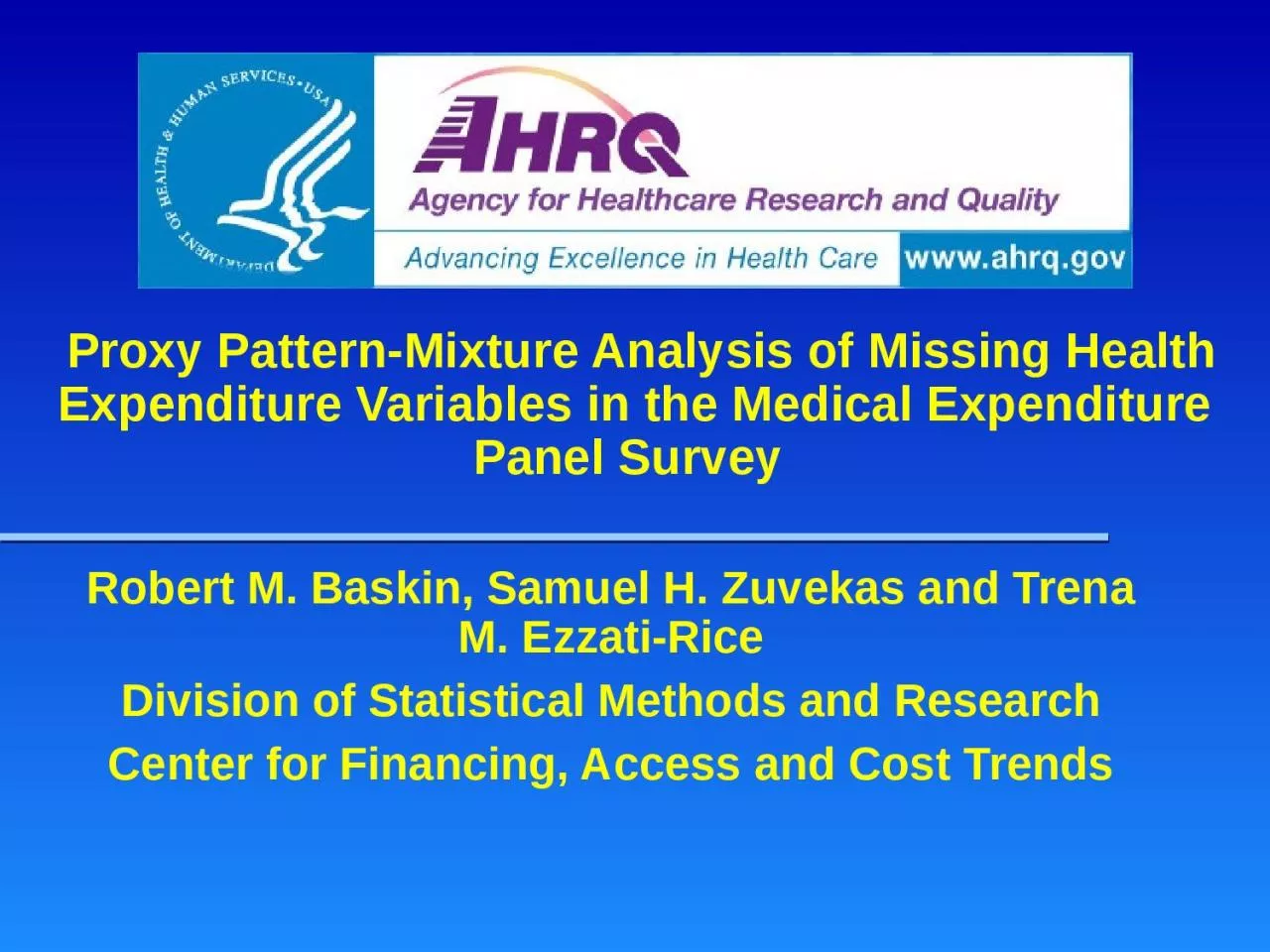

Robert M Baskin Samuel H Zuvekas and Trena M EzzatiRice Division of Statistical Methods and Research Center for Financing Access and Cost Trends Purpose of Study Use Fraction of Missing Information FMI to evaluate new item imputation ID: 1041695
Download Presentation The PPT/PDF document "Proxy Pattern-Mixture Analysis of Missin..." is the property of its rightful owner. Permission is granted to download and print the materials on this web site for personal, non-commercial use only, and to display it on your personal computer provided you do not modify the materials and that you retain all copyright notices contained in the materials. By downloading content from our website, you accept the terms of this agreement.
1. Proxy Pattern-Mixture Analysis of Missing Health Expenditure Variables in the Medical Expenditure Panel Survey Robert M. Baskin, Samuel H. Zuvekas and Trena M. Ezzati-RiceDivision of Statistical Methods and ResearchCenter for Financing, Access and Cost Trends
2. Purpose of StudyUse Fraction of Missing Information (FMI) to evaluate new item imputation methodology in Medical Expenditure Panel Survey (MEPS)Expenditures for hospitals and office-based physicians from MEPS 2008 will be used.
3. Medical Expenditure Panel Survey ComponentsHC -- Household ComponentMPC -- Medical Provider ComponentIC -- Insurance Component
4. What is MEPS-HCAnnual Survey of ~15,000 households: Provides national estimates of health care use, expenditures, insurance coverage, sources of payment, access to care and health care qualityPermits studies of: Distribution of expenditures and sources of paymentRole of demographics, family structure, insuranceExpenditures for specific conditionsTrends over time
5. MEPS-HC Survey DesignNationally representative sub-sample of responding households from previous year’s National Health Interview Survey (NHIS)Covers civilian non-institutionalized populationSelected from ~ 200/400 NHIS PSUsFive CAPI interviews cumulate data for 2 consecutive yearsOverlapping panels for annual dataTwo panels in field concurrently
6. MEPS-HC Core Interview ContentDemographicsHealth StatusConditionsEmploymentHealth InsuranceHealth Care Use & Expenditures
7. Non-response in MEPSUnit non-response - weighting adjustmentItem non-response - imputation The following ignores unit non-response
8. MEPS-MPC Survey of medical providers that provided care to MEPS sample personsSigned permission forms required to contact providersPurpose is to collect data that can be difficult for HC respondents to report completely or accuratelyCharges and paymentsDates of visit, diagnosis and procedure codesNot designed as independent nationally representative sample of providers
9. Primary Uses of MPC DataSupplement or replace expenditure data reported in HCImputation sourceMethodological studies
10. MPC - Targeted SampleAll providers for households with Medicaid recipientsAll hospitals and associated physiciansAbout ½ of office-based physiciansAll home health agenciesAll pharmacies
11. Linking MPC to HC DataProbabilistic record linkage approach Primary variables used:DateEvent Type Medical condition(s)Types of services
12. Final MEPS Expenditure DataGeneral approachMPC data used when available HC data used when no MPC data availableEvents with no expenditure data from MPC or HC are imputedMPC data generally preferred donor
13. Sources of Expenditure Data for Selected Event Types, 2008Data SourceHospital Inpatient StaysOffice-Based Physician VisitsMPC61%23%HC3%17%Partially Imputed--25%Fully Imputed36%35%
14. Method of Imputation1996-2007: Weighted Sequential Hotdeck within imputation cells2008: Office Based Visits used Predictive Mean Matching (PMM)2009: 4 Event Types will use PMM -Office Based Visits -Out Patient -Emergency Room -In Patient
15. Predictive Mean MatchingFor each event type recipients are classified into subgroups based on available predictors of total paymentsFor each subgroup four models are built based on donor data
16. Four ModelsBasic: all predictors in hotdeck - no transformationExpanded: add GPCI codes (Medicare geographic payment codes) and chronic conditions (e.g. diabetes) - no transformation - log of payments - square root of payments
17. Model R-Squared2008 MEPSModel TypeHospital Inpatient StaysOffice-Based Physician VisitsBasic.54.61Expanded.56.62Log transform.61.20Square Root Transform.60.66
18. Proxy Pattern-Mixture ModelsThe stated purpose of the study is to use Proxy Pattern-Mixture models to evaluate the effect of missingness on the estimates of mean - Little (1994) describes analyzing the data based on the pattern of missingness
19. Proxy Pattern-Mixture ModelsLikelihood based f(Y, X, M| θ,π)= f(Y, X | M, θ) f(M|π) - Y=dependent variable with missingness - X=covariates - M=missingness indicator
20. Proxy Pattern-Mixture Assumptions f(Y, X | M, θ) is estimable from respondents f(M| Y, X, θ) is an increasing function of X + λY λ is assumed to be known – it is not estimable from the data
21. Proxy Pattern-Mixture AssumptionsIf f(M| Y, X, θ) is an increasing function of X + λY λ = 0 is equivalent to missing at random λ = 1 is equivalent to Heckman selection λ = ∞ is equivalent to Brown model
22. Proxy Pattern-Mixture Estimate of BiasIf f(M| Y, X θ) is an increasing function of X + λY then the maximum likelihood estimate of the bias in estimating the mean using respondents is given by
23. Percent Bias Estimate from Proxy Pattern-Mixture AnalysisHospital Inpatient Stays(resp mean=$10,404)Office-Based Physician Visits(resp mean=$194)λ=0 (MAR)0.13%.01%λ=1 (Heckman)0.15%.13%λ=∞ (Brown)2.5%2.9%
24. Proxy Pattern-Mixture Models and FMI“The FMI due to non-response is estimated by the ratio of between-imputation to total variance under multiple imputation. Traditionally one applies this under the assumption that data are MAR, but we propose its application under the pattern-mixture model where missingness is not necessarily at random.” (from Andridge and Little)
25. FMI vs PPMAThe Pattern Mixture-Model estimates the bias in using the mean of respondents (complete case analysis)FMI estimates the ‘uncertainty’ in using the mean including imputed values
26. PMM Percent Bias Estimate and FMIHospital Inpatient StaysOffice-Based Physician Visitsλ=0 (MAR)0.13%.01%λ=1 (Heckman)0.15%.13%λ=∞ (Brown)2.5%2.9%FMI(adjusted for unequal weights)17%(11%)
27. Respondent Means vs Imputed MeansHospital Inpatient StaysOffice-Based Physician VisitsRespondent Mean(SE)$10404($420)$194($4)Mean with imputations(SE without MI)$10,061($310)$196($2)
28. SummaryItem imputation in MEPS is improved with use of available predictorsUnder assumptions for Proxy Pattern-Mixture models MEPS item imputation evaluated well